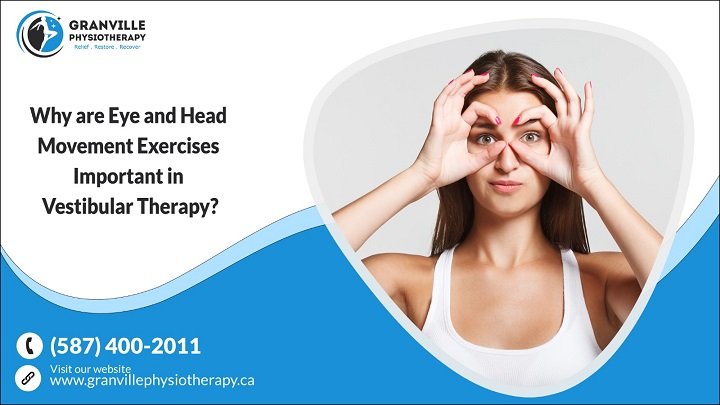Vestibular therapy involves a series of exercises designed to alleviate symptoms caused by vestibular disorders, such as vertigo, dizziness, and balance issues. Central to this therapy are eye and head movement exercises. These exercises are crucial because they help retrain the brain to accurately interpret the signals it receives from the inner ear, thereby improving coordination and balance. By systematically challenging the vestibular system, patients can significantly reduce their symptoms and enhance their quality of life. Vestibular physiotherapy in Edmonton aims to meet the unique symptoms of each individual, and the complexity of the therapy may vary depending on the severity of the condition.
Understanding Vestibular Disorders
Vestibular disorders stem from damage or disease affecting the vestibular system, comprising components of the inner ear and brain that handle processing sensory information involved in controlling balance and eye movements. Common disorders include (BPPV) benign paroxysmal positional vertigo, Meniere’s disease, and vestibular neuritis. Each condition triggers a unique set of challenges, primarily revolving around vertigo and dizziness, which can significantly impair an individual’s ability to perform daily activities.
The Importance of Eye and Head Movement Exercises:
Vestibular therapy is an essential treatment approach for individuals struggling with dizziness, balance issues, and various forms of vertigo. A key part of this therapy involves performing eye and head movement exercises. These specific exercises may seem simple, but their impact on improving balance and reducing symptoms of vestibular disorders is significant. By understanding why these movements are so important and how they work, it becomes clear why they form a core part of any vestibular rehabilitation program.
The Mechanism Behind Eye and Head Movement Exercises:
Vestibular physiotherapy in Edmonton aims to restore the brain’s ability to process information from the vestibular system and coordinate it with inputs from the eyes, muscles, and joints. Eye and head movement exercises are an integral part of this process. These exercises are designed to:
Improve Vestibulo-Ocular Reflex (VOR):
The vestibulo-ocular reflex helps stabilize vision during head movements. If this reflex isn’t functioning properly, even minor head movements can cause blurred vision or dizziness. By performing repetitive eye and head movement exercises, the brain is trained to improve this reflex, leading to clearer vision and better balance.
Enhance Gaze Stability:
These are designed to improve the ability to maintain the eyes focused on a still object while the head moves. For example, a common exercise might involve fixing the eyes on a single point (like a letter on a wall) while shaking the head from side to side. These exercises help the brain adapt to abnormal signals from the inner ear, improving both focus and balance.
Increase Coordination between Eye and Head Movements:
In everyday activities, the eyes and head must often work together seamlessly. For instance, looking at a moving object while walking or turning requires coordinated eye and head movements. By practicing specific exercises, individuals can improve this coordination, making movements feel smoother and more controlled. This is particularly beneficial for reducing dizziness and disorientation during daily activities.
Types of Eye and Head Movement Exercises
Eye and head movement exercises are pivotal in vestibular therapy, offering tailored approaches to mitigate the symptoms of various vestibular disorders. These exercises not only help in improving balance and gaze stability but also contribute significantly to enhancing the quality of life for patients with vestibular conditions.
Gaze Stabilization Exercises
- How to Perform: Select a fixed object at eye level and keep your gaze locked on it while moving your head side-to-side or up and down. Start slowly and increase the speed as you get more comfortable.
- Benefits: These exercises strengthen the vestibulo-ocular reflex (VOR), improving vision stability and reducing visual blurring during head movements. They are beneficial for maintaining stability in daily activities.
Brandt-Daroff Exercises
- How to Perform: Sit on the edge of a bed, lie down to one side with your head turned upwards, and remain in position until dizziness stops. Sit up and repeat on the other side. Perform slowly, several times daily.
- Benefits: Helps relocate debris in the inner ear canals, reducing vertigo frequency and enhancing balance and movement control.
Head-Eye Coordination Exercises
- How to Perform: Focus on a target (like a fingertip) and move it in various directions while following it with your head and eyes. Perform seated or standing based on your balance.
- Benefits: Improves coordination between visual and vestibular inputs, enhancing focus on moving objects and stabilizing gaze, which is crucial for complex activities like sports or driving.
Balance Exercises with Head Movements
- How to Perform: Integrate head movements while performing balance tasks like walking a straight line or standing on one leg. Adjust the difficulty based on progress.
- Benefits: These exercises enhance motor control and proprioceptive feedback, improving dynamic balance and reducing the risk of falls, thereby boosting independence and mobility confidence.
Bringing Balance Back:
Eye and head movement exercises help improve gaze stability, reduce dizziness, and enhance balance by retraining the brain to adjust to the challenges of vestibular dysfunction. Whether you’re facing issues like vertigo, imbalance, or motion sensitivity, these exercises can significantly accelerate vestibular recovery. Vestibular physiotherapy in Edmonton offers personalized treatment plans that address specific symptoms and conditions. Granville Physiotherapy Edmonton provides expert guidance to ensure a safe and effective recovery process, helping you regain balance and control in your daily life.

